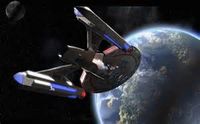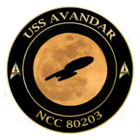Avandar Science Labs
| USS Avandar | ||
|---|---|---|
 INACTIVE STATUS | ||
| ||
A science laboratory (for short, lab or science lab) is any area set up for work in experimental or observational science. The USS Avandar has multiple labs. The information can be found below regarding these.
Chief Science Officer’s Office
The Chief Science Officer's Office is located on Deck 9 close to the labs. The CSO's Office receives data from all science areas on the ship.
Astrometrics & Stellar Cartographic Lab
Astrometrics is a specialized lab used aboard Federation starships for stellar cartographic purposes. Onboard the USS Avandar these labs are joined into one and can be found on Deck 2.
Astrophysics Lab
Astrophysics is a branch of astronomy that deals with the physics of astronomical objects in the universe. One who studies in this field is known as an astrophysicist. Onboard the USS Avandar these labs are joined into one and can be found on Deck 9.
Arboretum
The Arboretum is a botanic garden found onboard. Crewmembers may use the Arboretum as a recreation area where they can relax in a natural setting. It is also an area of scientific research.
Exobiology Lab
Exobiology (also called astrobiology or xenobiology) is the biological science concerned with living alien organisms. Exobiology is also a course taught at Starfleet Academy. A biologist who specializes in the field of exobiology is referred to as an exobiologist, astrobiologist, or xenobiologist. The sub-discipline known as comparative xenobiology is the scientific study of the physiological features of various alien lifeforms.
Cybernetics Lab
Cybernetics is the study of hugely complex artificial intelligence systems, usually running on a positronic matrix and often housed inside robotic machine technology. A practical implementation of this is an android. The scientists who study in this field are known as cyberneticists.
Geology Lab
Geology is the science involving the study of the natural landforms of a planet or other celestial body with a solid surface. One who studies geology is known as a geologist or exogeologist.
Hydroponics Bay
Hydroponics is the growing of plants in a medium other than soil, such as a nutrient-rich liquid.
Hazardous Materials Lab
The Hazardous Materials Lab is on deck 11, it's used for the storage and research of dangerous materials such as explosive, toxic, highly corrosive or flammable materials or severe biological threats such as viruses. The lab is equipped with extra protection and security protocols to make it a safe place to conduct experiments that would be deadly if something went wrong. These measures include reinforced walls, extra scrubbers for air filtering, sensors monitoring the internal environment, forcefields, hazard suits, specially designed containers and storage facility.
The lab is controlled inside and out via consoles. The research area has a console built into one end of the table to allow various functions to be performed whilst within a quarantined research enviromnent. There is a warning light at the entrance to the room that indicates if the room is being used. If the room is in use permission must be gained before entering.
Science Labs 1-10
Science labs 1-10 are small multi propuse labs.
Sensor Pod/Sensor Arrays
The Sensor Pod is Accessed from Deck 5 Via Turbo lift to Deck B. A sensor pod is a module that can be connected to the dorsal surface of a starship to extend a starship's sensor capability. The pod lets the ship perform multiply types of scans at the same time.
Types of scans
- antiproton beam
- autonomic response analysis
- geological scan
- high-resolution scan
- passive high-resolution series
- internal scan
- long range sensor scan
- magneton scan
- navigational scan
- multiphasic scan
- subspace differential pulse
- Inverse tachyon pulse
- virtual positron imaging scan
Sensor Tech
Long Range
- Type: Class 7/Beta Omni-directional
- Range: 5 LY High Resolution, 17 LY Low Resolution
Lateral Sensors
- Type:Class 10/Beta
- Range: 1 LY High Resolution
- Type:Type 8/Gamma
- Range: 4.7 LY
- Arc: 20 degree forward focus
Probe's
A probe was an automated spacecraft used to gather information. Probes were often used for tasks that starships were not suited to handle.
Tasks included:
- Collecting information in environments that were too small for starships to examine
- Collecting information in environments that were too dangerous for starship to examine
- Extreme long-term deep space exploration.
Probes: 80 (mixed class)


